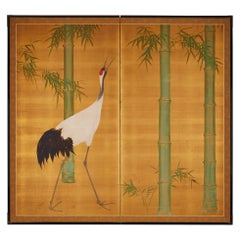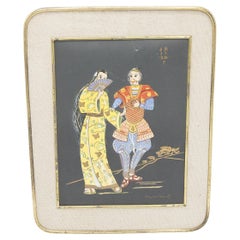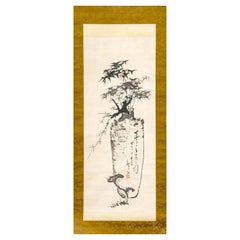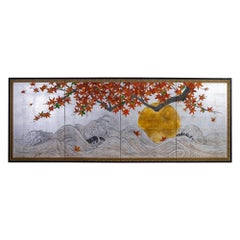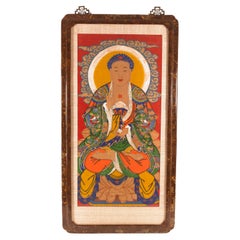Fabric Paintings and Screens
to
143
445
172
701
78
7
38
23
12
5
3
1
1
1
1
59
266
376
85
145
85
28
17
3
18
10
11
17
10
11
1
786
759
730
545
505
681
620
497
81
50
786
765
771
30
2
2
2
2
Material: Fabric
Japanese Two Panel Screen: Bamboo and Manchurian Crane
Located in Hudson, NY
Kano style painting in mineral pigments on silk with a silk brocade border.
Category
Early 20th Century Japanese Fabric Paintings and Screens
Materials
Brocade, Silk
Antique Japanese Jute and Brass Painting 'First Date'
Located in Milano, IT
Ancient and very rare Japanese painting made in the early 1900s of fine Japanese manufacture. The painting has a rectangular brass frame, with rounded corners. Internally we see an a...
Category
Early 1900s Japanese Anglo-Japanese Antique Fabric Paintings and Screens
Materials
Brass
Antique Japanese Ink Hanging Scroll Hidaka Tetsuo with Wood Storage Box
Located in Atlanta, GA
A hanging ink (Sumi-e) silk scroll by Japanese Zen artist Hidaka Tetsuo (1791-1871). Well presented in brocade boarders and mounted on paperback, this scroll depicts "Three Noble Friends in Winter" in a poetic and novel way. One of the favorite subjects by Chinese painters, the three noble friends in winter consists of pine, bamboo and plum flowers. They were admired for their characters of strength in cold resistance to remain evergreen and even blossom in unfavorable condition. The artist, however, composited the subjects in a none-conventional way as Ikebana. Bamboo and flowering plum branches were presented in an oversized pot...
Category
19th Century Japanese Japonisme Antique Fabric Paintings and Screens
Materials
Brocade, Wood, Paper
Japanese Four Panel Screen, Golden Sun Through Turbulent Surf
Located in Hudson, NY
Golden sun viewed through red maple above turbulent waves. Mineral pigments on gold and silver ground with silk brocade border.
Category
Mid-20th Century Japanese Fabric Paintings and Screens
Materials
Gold Leaf, Silver Leaf
Landscape and Waterfall Nihonga Scene Showa Period Scroll Japan Artist
Located in Amsterdam, Noord Holland
Some errors will occur in the dimensions. Please understand.
Status: The condition is good, but please understand stains, wrinkles, and stains.
Measures: Axis vertical 193 cm, hori...
Category
1930s Japanese Showa Vintage Fabric Paintings and Screens
Materials
Silk
Framed Shakyamuni Buddha Thangka Painting
Located in Miami, FL
Offered is a vibrant and intricate Tibetan Buddhist "thangka" (also known as "tangka", "thanka", or "tanka"), which is what a painting that serves as a visual representation of spiri...
Category
1960s Tibetan Tibetan Vintage Fabric Paintings and Screens
Materials
Bronze, Gold Leaf
Japanese Two-Panel Screen Peony, Wisteria, Cherry and Bamboo on Soft Silver
Located in Hudson, NY
Japanese two-panel screen: Peony, Wisteria, cherry and bamboo on soft silver, Meiji period (1868-1912) painting of a garden in spring. Painted in mineral pigments on oxidized silver ...
Category
Early 1900s Japanese Meiji Antique Fabric Paintings and Screens
Materials
Silver Leaf
Vintage Chinese Peacocks & Flowers Handpainted Silk Scroll – Marked Zhang Daqian
Located in 景德镇市, CN
Elevate your space or collection with this stunning vintage Chinese handpainted silk scroll featuring elegant peacocks and blooming flowers—symbols of beauty, nobility, and prosperity in Chinese culture. Meticulously painted with fine ink and watercolor on silk, the composition demonstrates exceptional detail and balance, capturing the grace and vibrancy of the natural world.
Elevate your collection with this exquisite Vintage Chinese Silk Scroll...
Category
20th Century Fabric Paintings and Screens
Materials
Silk
Japanese Silk Painting of Young Girl, Framed
Located in Bradenton, FL
Unique 19th Century painting of a Japanese girl standing atop a large furry mythical creature, with a small bird flying in the left upper corner. Signed in top right corner. Soft ear...
Category
20th Century Japanese Anglo-Japanese Fabric Paintings and Screens
Materials
Silk, Wood, Paint
Lovely 20th Horii Ko Scroll Painting Japan Artist Flowers Painted
Located in Amsterdam, Noord Holland
Horii Ko?
1897 to 1990
Kyoto people
real name: Kiyotaro Horii
issue: Ko?
nurses: Kikuchi Chigiritsuki
Kyoto School of Arts & Crafts, Kyoto painting...
Category
Mid-20th Century Japanese Showa Fabric Paintings and Screens
Materials
Silk
Antique kimono textile art "Kobachi ~ Green Collection ~" by ikasu Green, Japan
By Kimono ikasu
Located in Setagaya City, JP
This work is inspired by the green color palette, and is framed in paulownia wood originally used for a kimono chest-of-drawers.
In this artwork, the aim was to capture the wide pal...
Category
1920s Japanese Japonisme Vintage Fabric Paintings and Screens
Materials
Silk, Wood
Japanese Six Panel Screen Battle of Yashima from the Heike Monogatari
Located in Hudson, NY
Yamato-e painting depicting a great land and sea battle, the Battle of Yashima, March 22, 1185. The Heike were flushed from the mountainous and prote...
Category
18th Century Japanese Antique Fabric Paintings and Screens
Materials
Gold
Vintage kimono textile art "Sunset Timelapse ~Ephemerality~" by ikasu Red, Japan
By Kimono ikasu
Located in Setagaya City, JP
The art piece uses two sides - front and reverse - of the same kimono, to show beautiful sea surrounding Japan, in hues and in late sunset, as a timelapse.
The frame for this work is made of paulownia wood taken from antique Kiritansu - chest-of-drawers for kimono.
I use antique kiritansu that can’t be used as furniture anymore to create basis and frames for my works. It adds them even more authentic atmosphere of traditional wabisabi spirit. Can you feel it?
<< Period / Story >>
The kimono used in this piece was originally crafted during Showa period (around 1960ies).
<< Explanation and meaning of pattern and colors >>
Sea waves, depicted in two color variations here, are a symbol of transience and Impermanence in Japanese culture. The ebb and flow of the tides, the ever-changing currents, and the relentless motion of the waves serve as reminders of the fleeting nature of life. This artwork featuring the sea convey themes of impermanence, reminding viewers to cherish the present moment and appreciate the beauty of life's fleeting moments.
The theme of impermanence is strengthen by two colors of the sea - the lighter in early hues and the darker when the sun is just about to set in the sea.
<< About the frame >>
This artwork frame is crafted from paulownia wood, a uniquely Japanese material closely tied to the world of kimonos, and it serves to convey the refined beauty of Japanese nature.
Paulownia wood is known as the lightest wood in Japan, prased for its natural luster, resistance to moisture, and resilience against cracking. Since ancient times, it has been used in crafting furniture, chests, and musical instruments.
Paulownia wood is closely linked to kimono culture. During the Edo period (17th cent.~), it became customary to store cherished kimonos in paulownia chests...
Category
1960s Japanese Japonisme Vintage Fabric Paintings and Screens
Materials
Silk, Wood
Framed Korean Jakhodo Tiger and Magpie Folk Painting One of the Four
Located in Atlanta, GA
A Korean Folk Art painting watercolor on silk mounted with brocade border and framed. The watercolor was likely dated from late 19th century to the tur...
Category
Late 19th Century Korean Folk Art Antique Fabric Paintings and Screens
Materials
Brocade, Silk, Wood
Japanese Two Panel Screen: Moon and Flowers
Located in Hudson, NY
Showa period (1926 - 1989) painting with a strong design of exotic lilies and a cluster of nadeshiko (dianthus) under a silver moon on gold. This painting has a modern flair, which ...
Category
20th Century Japanese Fabric Paintings and Screens
Materials
Silver
18th Century Japanese Two-Panel Screen Collection of Fans on Gold
Located in Hudson, NY
18th century Japanese Screen of a Collection of Fans. Paintings on fans depict famous Japanese painting subjects, this screen was most li...
Category
18th Century Japanese Edo Antique Fabric Paintings and Screens
Materials
Gold Leaf
Japanese Two Panel Screen: Horses in Stable
Located in Hudson, NY
A pair of captivating black and white horses, believed to define hard work and power in Japanese mythology, are beautifully rendered in this painting of mineral pigments on mulberry ...
Category
Early 19th Century Japanese Antique Fabric Paintings and Screens
Materials
Bronze, Gold Leaf
Japanese Two Panel Screen: Craggy Landscape on Gold Sil
Located in Hudson, NY
Dramatic Mountain landscape with gnarled pines. Signature reads: Shunsen. Ink painting on gold silk with silk brocade border.
Category
Early 20th Century Japanese Fabric Paintings and Screens
Materials
Brocade, Silk
Japanese Four Panel Screen: Early Spring Into Summer
Located in Hudson, NY
Japanese Four Panel Screen: Early Spring Into Summer, Meiji period (1868 -1912) painting of plum in bloom with red camellias on the right and peony and thistle on the left. A clutc...
Category
Early 1900s Japanese Meiji Antique Fabric Paintings and Screens
Materials
Gold Leaf
Japanese Six Panel Screen, Egrets in Water Landscape with Lotus and Loquats
Located in Hudson, NY
Hasegawa School painting in ink and gold dust accents on mulberry paper.
Category
Mid-19th Century Japanese Antique Fabric Paintings and Screens
Materials
Gold
Vintage kimono textile art "Fern ~Connection to Nature~" by ikasu Black , Japan
By Kimono ikasu
Located in Setagaya City, JP
This work uses an antique tomesode (festive kind of kimono) with fern design to evoke feelings of tranquility, harmony, and appreciation for the beauty of the environment. Can be used both vertically and horizontally.
It is elegantly framed with paulownia wood originally used for kimono chest-of-drawers, and is filled with storytelling and sense of luxury.
I used pieces of kimono that could no longer be used as clothing and kiritansu chest-of-drawers that would normally be discarded to create the ultimate upcycled piece.
<< Explanation of colors and patterns >>
In Japanese traditional culture, ferns, particularly the Japanese painted fern (Athyrium niponicum), hold several meanings and symbolisms:
・Elegance and Beauty: Ferns are admired for their graceful, delicate appearance and intricate leaf patterns. In Japanese aesthetics, they are appreciated for their natural beauty and are often used in gardens, landscapes, and floral arrangements to add a sense of refinement and elegance.
・Resilience and Perseverance: Ferns are known for their ability to thrive in diverse environments, including shady forests, rocky cliffs, and damp soil. Their resilience in the face of challenging conditions is seen as a symbol of endurance and perseverance. In Japanese culture, ferns may represent the ability to overcome adversity and flourish despite obstacles.
・Connection to Nature and Tranquility: Ferns are native to forested areas and are often associated with the natural world. In Japanese traditional culture, they symbolize a deep connection to nature and the importance of maintaining harmony with the environment. The lush green foliage of ferns evokes feelings of tranquility and peacefulness, making them popular motifs in Zen gardens and traditional landscape paintings.
・Purity and Simplicity: Ferns are emblematic of simplicity and purity in Japanese aesthetics. Their unassuming beauty and understated elegance reflect the principles of wabi-sabi, an aesthetic worldview that values imperfection, impermanence, and simplicity. Ferns may be used in tea ceremonies, Ikebana (flower arranging), and other traditional arts to evoke a sense of tranquility and appreciation for life's fleeting moments.
Overall, ferns in Japanese traditional culture symbolize elegance, resilience, connection to nature, purity, and simplicity. Their presence in art, literature, and landscape design underscores their enduring significance as symbols of natural beauty and spiritual resonance.
<< Characteristics of the fabric >>
This vintage textile is hand-painted with a traditional Japanese technique called "yuzen".
<< About the frame >>
Kiritansu - chest-of-drawers for kimono, is traditionally made from paulownia wood, a uniquely Japanese material closely tied to the world of kimonos.
Paulownia wood is known as the lightest wood in Japan, prased for its natural luster, resistance to moisture, and resilience against cracking. Since ancient times, it has been used in crafting furniture, chests, and musical instruments.
During the Edo period, it became customary to store cherished kimonos in paulownia chests...
Category
1960s Japanese Japonisme Vintage Fabric Paintings and Screens
Materials
Silk, Wood
K10 Japanese Antiques Hanging scroll, Cherry blossom painting, silk
Located in Niiza, JP
Cherry blossom painting
Silk Scroll tip: wood
Image size: 410 (W) x 1200 (H) [mm]
Scroll mounting: 570 (W) x 2180 (H) [mm]
Box size: 80 x 75 x 700 mm 970g
Comes with a box, although...
Category
19th Century Japanese Antique Fabric Paintings and Screens
Materials
Silk
B14 Japanese Antiques 2panels, silk, folding Screen with Gold basGold base
Located in Niiza, JP
Red plum
Material: Silk on wooden frame
One piece: W685×H1520mm×D20mm,
Unfolded size: W1370mm
Folded size: W685×H1520×D40mm, 6kg
Packaging (sandwiched with 5mm plywood): 10cm x 77cm ...
Category
20th Century Japanese Fabric Paintings and Screens
Materials
Silk
B13 Japanese Antiques 2panels, silk, folding Screen with Tiger
Located in Niiza, JP
Material: Silk on wooden frame
One piece: W685×H1525mm×D20mm,
Unfolded size: W1370mm
Folded size: W685×H1525×D40mm, 5kg
Packaging (sandwiched with 5mm plywood): 10cm x 77cm x 160cm, ...
Category
20th Century Japanese Fabric Paintings and Screens
Materials
Silk
Japanese Two-Panel Screen, Summer Flowers on Silk
Located in Hudson, NY
Rimpa painting of flowers including morning glories, hollyhocks, sweet peas, nadeshiko, and daisies. Signature and seal read: Bisui
Category
Late 19th Century Japanese Meiji Antique Fabric Paintings and Screens
Materials
Silk, Wood
Lovely 20th Century Sen'yo Ogawa Scroll Painting Japan Artist Flowers Painted
Located in Amsterdam, Noord Holland
Sen'yo Ogawa
1882-1971
Japan painter. Kyoto production. Name Tasaburo. After served as apprentice of the Buddhist teacher, I learned a Movie to Chu Asai, exhibited oil paintings to...
Category
Mid-20th Century Japanese Showa Fabric Paintings and Screens
Materials
Silk
Japanese Two-Panel Screen Temples Through Misty Forest
Located in Hudson, NY
Japanese two-panel screen: Temples Through Misty Forest. Chinese School landscape ink painting on gilded silk by Yukimatsu Shunpo, signed and dated 1924. Yukimatsu Shunpo was born in...
Category
1920s Japanese Taisho Vintage Fabric Paintings and Screens
Materials
Silk, Wood
Impressionist Oil on Canvas by Henry George Bogert
By George Henry Bogert
Located in Dallas, TX
Fine early 20th century American Impressionist oil on canvas by George Henry Bogert. Circa 1910. Adds warmth and charm to any room! 47W x 39H
Category
20th Century Fabric Paintings and Screens
Materials
Canvas
Vintage obi textile art " Camellia ~ Serendipity ~ " by ikasu Blue, Japan
By Kimono ikasu
Located in Setagaya City, JP
This work is inspired by traditional Japanese nature motifs symbolism, and is framed in paulownia wood originally used for a kimono chest-of-drawers.
In this artwork, the aim was to capture the the auspicious symbol of camellia used in antique kimono. Traditional Japanese culture, represented by the kimono, and wood, an integral element of Japanese craftsmanship, were used to bring this vision to life.
I used pieces of kimono that could no longer be used as clothing and kiritansu chest-of-drawers that would normally be discarded to create the ultimate upcycled piece.
<< Explanation and meaning of pattern and colors >>
This delicate piece features hand-drawn camellia motifs flowing gracefully on a softly brightened grayish background.
Camellias, native to Japan, bloom from winter to early spring. As an evergreen tree with green leaves throughout the year, it symbolizes the anticipation of spring and is considered an auspicious plant. Due to its seasonal significance and auspicious meanings, camellias have been used as motifs symbolizing good fortune. Additionally, they were highly valued for their use in oil, cosmetics, and medicine, representing nobility. Believed to possess the power to ward off misfortune, camellias also carry the meaning of "protection from calamity" and have strong ties to traditional ceremonies. In this artwork, camellias are delicately depicted alongside flowing branches, subtly representing good fortune with their pale pink and white hues.
"Sora-iro nezumi 空色鼠" refers to a light grayish color with a hint of blue, reminiscent of the slightly brightened sky on a lightly cloudy day. Popular during the late Edo period (19th cent.), it elegantly captures the slightly brighter sky pattern seen on lightly overcast days. Notably, the term "nezumi-iro" (mouse gray), popular during the late Edo period, was paired with brown tones, collectively known as "Forty-eight Teas and a Hundred Mice 四十八茶百鼠." Colors within the "nezumi" (gray) spectrum, particularly "sora-iro nezumi," were favored by young people for their cool and sophisticated appeal.
<< Characteristics of the fabric >>
The fabric features intricately woven patterns that reveal subtle gradations through dyeing, creating a grid pattern that transforms depending on the light conditions.
Originally, this fabric was part of a formal kimono known as a "hōmongi 訪問着," featuring motifs along the hem, shoulders, and sleeves. These motifs have been carefully selected and combined to create a unified piece of artwork.
<< About the frame >>
Kiritansu - chest-of-drawers for kimono, is traditionally made from paulownia wood, a uniquely Japanese material closely tied to the world of kimonos.
Paulownia wood is known as the lightest wood in Japan, prased for its natural luster, resistance to moisture, and resilience against cracking. Since ancient times, it has been used in crafting furniture, chests, and musical instruments.
During the Edo period, it became customary to store cherished kimonos in paulownia chests...
Category
1960s Japanese Japonisme Vintage Fabric Paintings and Screens
Materials
Silk, Wood
Japanese Two-Panel Screen, Deer in Cedar Landscape
Located in Hudson, NY
Originally fusuma doors, three deer stand in a clearing in a pine forest with gold leaf mist. Mid Edo period painting in mineral pigments on gold leaf wi...
Category
18th Century Japanese Edo Antique Fabric Paintings and Screens
Materials
Gold
Scroll Kitsuda Eihô (1902 - 1974) Breaking of Dawn in the Mountains Japanese
Located in Amsterdam, Noord Holland
Kitsuda Eihô (1902 - 1974) Aanbreken van de dag in de bergen
Rolschildering / scroll op zijde, houten rollers, in houten cassette. Herkomst: Oranda Jin. B 128 x 41.9 / 202 x 56.3 cm...
Category
Mid-20th Century Japanese Meiji Fabric Paintings and Screens
Materials
Silk
VIntage kimono textile art " Monochrome Geometry " by ikasu Gold, Grey, Japan
By Kimono ikasu
Located in Setagaya City, JP
This work is inspired by traditional Japanese nature colors symbolism, and is framed in paulownia wood originally used for a kimono chest-of-drawers.
It is filled with storytelling ...
Category
1960s Japanese Japonisme Vintage Fabric Paintings and Screens
Materials
Silk, Wood
Nightingale on Branch Meiji Period Scroll Japan 19/20c
Located in Amsterdam, Noord Holland
Very Lovely painting.
Category
Mid-19th Century Japanese Meiji Antique Fabric Paintings and Screens
Materials
Silk
Japanese Six Panel Screen: Mandarin Ducks in Snowy Pond in Early Spring
Located in Hudson, NY
Kano School painting of a craggy plum tree with branches over a pond with stylized ripples in the water. Some early spring flowers by pond's edge. Mineral pigments on gold leaf with ...
Category
Late 19th Century Japanese Antique Fabric Paintings and Screens
Materials
Gold Leaf
Lovely circa 1900 C-Scroll Paintings Japan Artist Signed Figures in Landscape
Located in Amsterdam, Noord Holland
Title: ???? ??????? ?? ?? ?? ?? ?? ??
Condition: State is good, thin stains.
Size Axis ... vertical 216.5cm next to 56.3cm
Painting ... vertical 126.3cm horizontal 41.5cm ? diff...
Category
20th Century Japanese Taisho Fabric Paintings and Screens
Materials
Fabric
19th Century a Pair of Chinese Silk Fans with Giltwood Handles
Located in Brea, CA
Antique 19th century hand painted floral motifs on silk Chinese fans Qing dynasty, the fan in silk with silk fringe and giltwood handles, housed within a conforming paper covered box...
Category
Late 19th Century Chinese Qing Antique Fabric Paintings and Screens
Materials
Silk
VIntage kimono textile art "Geometry ~Marble~" by ikasu Gold, White, Grey, Japan
By Kimono ikasu
Located in Setagaya City, JP
This work is inspired by traditional Japanese nature motifs symbolism, and is framed in paulownia wood originally used for a kimono chest-of-drawers.
It is elegantly framed with pau...
Category
1960s Japanese Japonisme Vintage Fabric Paintings and Screens
Materials
Silk, Wood
Japanese Two Panel Screen, Ink Landscape on Paper with Gold Dust
Located in Hudson, NY
Sesshu-style painting in ink on mulberry paper with gold dust accents and a silk brocade border.
Category
19th Century Japanese Antique Fabric Paintings and Screens
Materials
Gold
Lake Awasaru Scene Meiji Period Scroll Japan 19c Artist Marked Nihonga Style
Located in Amsterdam, Noord Holland
As you can see, it is a Japanese painting "Lake Suwa Asaharu" figure / co-box.
It is a "Lake Suwa Asaharu" figure with gentle sunlight, and it is
a very tasty work combined with a ...
Category
Mid-19th Century Japanese Meiji Antique Fabric Paintings and Screens
Materials
Silk
Vintage kimono textile art " Plum Gradation " by ikasu Pink, White, Japan
By Kimono ikasu
Located in Setagaya City, JP
This canvas featuring a plum color gradient kimono showcases a unique decorative variation of the popular seigaiha (青海波) sea waves pattern.
The artwork got a Mr. & Mrs. Abe Arts & Cu...
Category
1980s Japanese Japonisme Vintage Fabric Paintings and Screens
Materials
Canvas, Silk
Japanese Four Panel Screen: Seasonal Poems
Located in Hudson, NY
Four individual mounted panels of calligraphy. Each panel contains a poem inspired by one of the four seasons. Each panel signed: To Rei. Ink on mulberry paper with silk brocade border.
Category
Mid-19th Century Japanese Antique Fabric Paintings and Screens
Materials
Brocade, Silk, Paper
Japanese Screen: Animals and Flowers in a Landscape with Rising Sun
Located in Hudson, NY
Edo period (c. 1800) screen, beautifully painted with excellent details. Kano School painting at its best. An exuberant Audobon landscape being observed by a cat and her kitten. A...
Category
Early 19th Century Japanese Edo Antique Fabric Paintings and Screens
Materials
Gold Leaf
"Literary Gathering" Chinese Scroll Painting, c. 1923
Located in Chicago, IL
Exquisitely painted with delicate line work and a subdued color palette, this Chinese scroll painting is an Late 20th-century reproduction of a...
Category
Late 20th Century Chinese Fabric Paintings and Screens
Materials
Silk, Paper
Tibetan Thangka of Amitabha Buddha Hand Painted Gilded
Located in Somis, CA
One of our finest hand painted Tibetan Thangkas from Nepal. This extraordinary Thangka depicts 108 Buddhas with consorts in celestial court witnessing Amitabha's achievement of nirva...
Category
2010s Nepalese Fabric Paintings and Screens
Materials
Gold Leaf
Lovely circa 1900 Scroll Paintings Japan Artist Shinsu Signed Crane in Landscape
Located in Amsterdam, Noord Holland
Jodo Shinshu Nishi Honganji
1862 years now, born as the second son of Okayama Prefecture Kasaoka Joshinji priest Akemi Tsuda.
His real name is Akirashirube.
He was a painter and a...
Category
19th Century Japanese Meiji Antique Fabric Paintings and Screens
Materials
Fabric
Chinese Export Hand-Painted Oil on Canvas Painting of Interior Scene w/ Emperor
Located in New York, NY
Chinese Export Exceptionally Hand-Painted Oil on Canvas Painting Depicting Musicians Playing Music for the Emperor while Seated on his Royal Throne. Beautifully executed with great d...
Category
Late 18th Century Chinese Chinese Export Antique Fabric Paintings and Screens
Materials
Canvas
Vintage kimono textile art "Flowers ~Life Circle~" by ikasu Pink, Black, Japan
By Kimono ikasu
Located in Setagaya City, JP
<< About this canvas >>
This canvas is crafted from three different haori fabrics, each adorned with a shibori dyeing flower motif going through entire fabric. These fabrics tell a ...
Category
1970s Japanese Japonisme Vintage Fabric Paintings and Screens
Materials
Canvas, Silk
Framed Korean Folk Painting of General Guan Gong
Located in Atlanta, GA
A Korean folk Shamanism watercolor on textile matted with woven brocade and presented in a wood frame with an oriental style metal hanging hardware. The painting was estimated to be from early 20th century circa 1910-1930s. It depicts Guan Yu (160-220AD), a legendary Chinese warrior and general from Eastern Han Dynasty. Long worshiped in China as a deity, across all three major religions, Guan Gong...
Category
Early 20th Century Korean Folk Art Fabric Paintings and Screens
Materials
Textile, Brocade
Japanese Two Panel Screen: Winter into Spring Floral Landscape
Located in Hudson, NY
With nandin, narcissus and chrysanthemums. Signature and seal read: Koun. Mineral pigments on mulberry paper with a silk brocade border.
Category
Early 20th Century Japanese Fabric Paintings and Screens
Materials
Brocade, Silk, Paper
Vintage kimono textile art " Cranes ~ Kintsugi ~ " by ikasu White/Red/Gold Japan
By Kimono ikasu
Located in Setagaya City, JP
The frame for this work is made of paulownia wood taken from antique Kiritansu - chest-of-drawers for kimono.
I use antique kiritansu that can’t be used as furniture anymore to create basis and frames for my works. It adds them even more authentic atmosphere of traditional wabisabi spirit. Can you feel it?
The piece uses the concept of "kintsugi" - it "unites" the pieces of antique kimono back together with golden leaf to give it a second wind as art work.
<< Period / Story >>
The kimono used in this piece was originally crafted during the late Showa period (1960-80ies).
<< Explanation and meaning of pattern and colors >>
The Japanese saying goes, "A crane lives a thousand years, a tortoise lives ten thousand years," making cranes a symbol of longevity.
Cranes are also known for staying with the same partner for their entire lives, which is why they are often used at weddings and other celebrations to symbolize "marital bliss" and the desire for harmony between husband and wife.
On this particular piece, cranes are flying through snow woven on the fabric, as if they are overcoming all the disasters to get to their beloved ones.
The color scarlet, or deeply dyed red, used for the most of the cranes here, has long been associated with the meaning of "warding off evil." It is believed to possess the power to repel malevolent forces and invite good fortune.
During the Heian period, scarlet was reserved for sacred buildings and ceremonial objects that held great significance. Ordinary people were prohibited from wearing scarlet-red kimonos, which made it a highly special color.
<< Characteristics of the fabric >>
Cranes, going up and down, are generously decorated by kimpaku here. "Kimpaku" (金箔) refers to gold leaf/foil in Japanese. Gold leaf is a traditional material used in various aspects of Japanese culture, including art, crafts, and even in culinary applications.
In traditional Japanese art, gold leaf is often applied to religious objects, sculptures, paintings, and lacquerware to create a luxurious and decorative effect. The use of gold leaf in art dates back centuries and is associated with a sense of wealth, prestige, and the divine.
Traditional kimpaku technique is used here to make an accent decoration in the middle.
<< About the frame >>
This artwork frame is crafted from paulownia wood, a uniquely Japanese material closely tied to the world of kimonos, and it serves to convey the refined beauty of Japanese nature.
Paulownia wood is known as the lightest wood in Japan, prased for its natural luster, resistance to moisture, and resilience against cracking. Since ancient times, it has been used in crafting furniture, chests, and musical instruments.
Paulownia wood is closely linked to kimono culture. During the Edo period, it became customary to store cherished kimonos in paulownia chests...
Category
Late 20th Century Japanese Japonisme Fabric Paintings and Screens
Materials
Gold Leaf
Japanese Six-Panel Screen "Wild Grasses and Peonies by Rivers Edge"
Located in Hudson, NY
Japanese Six Panel Screen: Wild Grasses and Peonies by Rivers Edge. Early Meiji period (1868 - 1912) painting of a grassy knoll next to a running brook or river. A soft breeze is m...
Category
1880s Japanese Meiji Antique Fabric Paintings and Screens
Materials
Gold Leaf
Japanese Two Panel Screen: Moonlit Landscape with Geese
Located in Hudson, NY
Geese amongst the reeds under a full moon. Mineral pigments on oxidized ground with silk brocade border. Signature reads: Yoshichi hitsu.
Category
Late 19th Century Japanese Antique Fabric Paintings and Screens
Materials
Brocade, Silk
Pair of Signed Antique Chinese Watercolour Silk Paintings of Geisha Girl Flowers
Located in West Sussex, Pulborough
We are delighted to offer for sale this lovely pair of antique circa 1920’s Chinese Export hand painted on silk paintings depicting a Geisha girl and a floral scene with butterfly.
A very good looking and beautifully painted pair, they were made for the export market during the British colonialism...
Category
1920s Chinese Chinese Export Vintage Fabric Paintings and Screens
Materials
Silk
Antique Thai White Elephant Painting on Cloth, Rattanakosin School
Located in Point Richmond, CA
Antique Thai White Elephant Painting on Cloth, Rattanakosin School, 19th Century.
A painted scene of two white auspicious elephants in a landscape setting. In Thai Buddhist folklore,...
Category
19th Century Thai Other Antique Fabric Paintings and Screens
Materials
Canvas
Antique kimono textile art " Peacock Feathers ~Royalty~ " by ikasu Blue , Japan
By Kimono ikasu
Located in Setagaya City, JP
This work uses an antique furisode (festive kind of kimono with long sleeves) with peacock feathers - a symbol of royalty and prosperity. Can be used both vertically and horizontally...
Category
Early 20th Century Japanese Japonisme Fabric Paintings and Screens
Materials
Gold Leaf, Silver Leaf
Japanese Two Panel Screen Psychedelic Forms
Located in Hudson, NY
Celestial images on hand-dyed tsumugi cloth. Makers mark: unreadable.
Category
Mid-20th Century Japanese Fabric Paintings and Screens
Materials
Fabric
Japanese Ink and Wash Scroll Painting by Watanabe Seitei
Located in Atlanta, GA
Watanabe Seitei, also known as Watanabe Shotei (1851–1918), was born in late Edo period. He was one of the earliest Japanese artists who visited and be...
Category
Early 1900s Japanese Japonisme Antique Fabric Paintings and Screens
Materials
Brocade, Silk, Paper
VIntage kimono textile art "Geometry ~Chrysanthemums" by ikasu, white, red Japan
By Kimono ikasu
Located in Setagaya City, JP
This work is inspired by traditional Japanese natural symbolism, and is framed in paulownia wood originally used for a kimono chest-of-drawers.
It is elegantly framed with paulownia...
Category
1960s Japanese Japonisme Vintage Fabric Paintings and Screens
Materials
Silk, Wood
